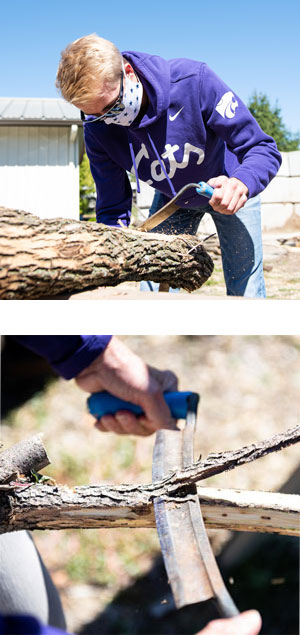October 2, 2020
Lavis explains girdled trap trees and use for detection of emerald ash borer on campus

You may have noticed something peculiar recently with a tree just to the north of Weber Arena. This tree had bark removed in a methodical manner about midway up the main trunk, perhaps causing someone passing by to wonder, "who would do this to a tree and why?" Cathie Lavis, professor of horticulture and natural resources, explains.
Kansas State University's Tree Campus USA/Landscape Advisory Committee has been prepared for the imminent arrival of the emerald ash borer, or EAB, an exotic, invasive insect that has been confirmed in 31 states and eight eastern Kansas counties, including Shawnee County.
The emerald ash borer causes significant damage to native and cultivated ash trees by disrupting the tree's ability to transport water and nutrients. The damage usually starts in the tree canopy and as the insect population builds in the tree, the damage becomes more severe and more noticeable, such as bark cracking.
Studies conducted by Michigan State University and the U.S. Department of Agriculture's Forest Service suggest that girdled ash trees are an effective detection tool for the emerald ash borer. Girdling ash by removing the bark and phloem around the entire circumference of the trunk creates an effective attractant for the insect. Emerald ash borer adults are attracted to stressed ash trees and lay more eggs on stressed versus healthy trees. The trees selected for this process are rated in poor to fair condition.
The ash tree north of Weber Arena was girdled in May 2019. This tree was allowed to stand for a growing season and then taken down this week by K-State facilities.
Now the tree is being processed by students in HORT 508: Landscape Maintenance. This process is called bark peeling. As the name implies, bark is actually peeled using a drawknife that allows visual observation of the tissue just under the bark where the emerald ash borer feeds. Bark is peeled off in thin layers from the outer bark through the inner bark. Although girdling and bark peeling are labor-intensive and involve the sacrifice of live trees, girdled trap trees are a good option for detection of the emerald ash borer.
By turning this into an educational opportunity for our campus community, we are attempting to find the silver lining of the tremendous loss of our beloved trees. Trees are being replaced as much as possible; in fact, since 2013, arboriculture students have planted approximately 35 trees as part of Arbor Day celebrations. K-State has been an Arbor Day Foundation Tree Campus USA since 2013.
Due to COVID-19, students were not able to participate in the girdling process during the spring 2020 semester. That is why it is exciting to have students learn the process of bark peeling during the fall 2020 semester. Students not only learn about the emerald ash borer, but they also gain skills that equip them for their futures as professional horticulturists.
Thanks to the efforts of Kim Bomberger with the Kansas Forest Service and members of the Tree Campus Advisory Committee, K-State has a five-year strategic EAB Readiness and Response Plan that formally started in 2018. View the PDF EAB Readiness and Response Plan for more information.
